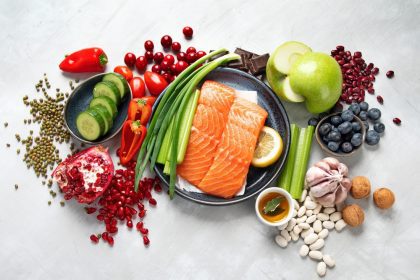The connection between diet and mental wellness has gained increasing attention in recent years, with certain nutrients emerging as key players in brain health. Among these, tryptophan stands out as a particularly fascinating compound with wide-ranging effects on mood, sleep, and overall well-being. While commonly associated with post-Thanksgiving dinner drowsiness, this essential amino acid deserves recognition for its critical role in numerous bodily functions year-round.
The surprising science behind tryptophan’s effects
Tryptophan represents one of nine essential amino acids the human body cannot manufacture independently, making dietary sources mandatory for maintaining optimal health. What distinguishes tryptophan from other amino acids is its unique role as a biochemical precursor to several crucial neurotransmitters and hormones that regulate mood, sleep cycles, and cognitive function.
The journey begins when tryptophan crosses the blood-brain barrier, a protective membrane separating circulating blood from brain tissue. Once inside the brain, tryptophan undergoes a series of biochemical transformations. First, it converts into 5-hydroxytryptophan (5-HTP), then into serotonin, a neurotransmitter intimately involved in mood regulation, appetite control, and social behavior.
Further metabolic processes transform some serotonin into melatonin, the hormone responsible for governing sleep-wake cycles. This biochemical pathway explains why adequate tryptophan levels contribute significantly to both emotional stability during waking hours and restorative sleep at night.
Why your body demands this nutrient daily
Unlike fat-soluble vitamins that the body can store for extended periods, tryptophan requires regular replenishment through diet. The average adult needs approximately 4-5 milligrams of tryptophan per kilogram of body weight daily, translating to roughly 280-350 milligrams for a 70-kilogram (154-pound) individual.
This requirement increases during periods of high stress, intense physical activity, or illness, when the body utilizes amino acids at accelerated rates for tissue repair and immune function. Pregnant and nursing women also need higher tryptophan intake to support fetal development and breast milk production.
Inadequate tryptophan consumption can contribute to irritability, anxiety, impaired concentration, and disrupted sleep patterns. Conversely, maintaining optimal levels supports cognitive function, emotional resilience, and improved stress management capabilities.
The 9 most powerful tryptophan sources to add to your meals
While turkey often receives credit as the premier tryptophan source, numerous other foods contain comparable or even higher concentrations of this essential amino acid. Incorporating these alternatives into your regular meal rotation ensures steady tryptophan intake while providing additional nutritional benefits.
- Soy products offer plant-based power
The soybean family provides some of the richest plant-based tryptophan sources available. Versatile and widely available in various forms, soy products deliver impressive tryptophan content alongside complete protein profiles.
Soy flour leads the category with approximately 422 milligrams per cup, making it an excellent option for baking and cooking. Cooked whole soybeans follow closely with 416 milligrams per cup, while fermented tempeh delivers 322 milligrams in the same serving size.
Tofu, a staple in many plant-based diets, contains approximately 139 milligrams per quarter block, with its mild flavor allowing it to absorb seasonings and sauces effectively. Even soy milk contributes meaningfully with 112 milligrams per cup, offering a dairy-free option for smoothies, cereals, and coffee.
- Seafood delivers multiple brain benefits
Various seafood options combine impressive tryptophan content with heart-healthy omega-3 fatty acids, creating a powerful nutritional synergy for brain health. This combination supports not only neurotransmitter production but also the structural integrity of brain cells.
Canned light tuna ranks particularly high with 326 milligrams per 3-ounce serving, making budget-friendly tuna sandwiches and salads legitimate mood-boosting meals. Fresh salmon provides approximately 225 milligrams per 3-ounce portion while simultaneously delivering anti-inflammatory omega-3s that complement tryptophan’s effects.
Shellfish varieties like shrimp (120 milligrams per 3 ounces) and mussels (175 milligrams per 3 ounces) offer additional options for diversifying seafood consumption. These sources provide the added advantage of vitamin B12, zinc, and selenium—all nutrients that support optimal neurological function.
- Poultry provides steady supply beyond Thanksgiving
While turkey’s reputation for causing drowsiness is somewhat exaggerated, poultry products do indeed deliver substantial tryptophan quantities alongside lean protein. Turkey breast contains approximately 252 milligrams per 3-ounce serving, while chicken breast follows closely with 237 milligrams in the same portion.
Duck meat offers a more indulgent option with 144 milligrams per 3-ounce serving, along with a richer flavor profile for special occasions. Game birds like pheasant and quail similarly provide respectable amounts while offering culinary variety.
The versatility of poultry makes it particularly valuable for consistent tryptophan consumption, as it can be prepared through numerous cooking methods and incorporated into countless recipes from soups and salads to sandwiches and main dishes.
- Seeds deliver concentrated nutrition in small packages
Various seeds pack remarkable nutritional density into tiny packages, delivering tryptophan alongside essential fatty acids, fiber, and micronutrients. These convenient options require no preparation and can easily enhance numerous dishes.
Pumpkin seeds stand out with approximately 110 milligrams of tryptophan per ounce, making them an excellent snack option or salad topping. Sunflower seeds follow with 84 milligrams per ounce, offering a more subtle flavor that complements both sweet and savory preparations.
Chia seeds contribute approximately 65 milligrams per ounce while simultaneously providing omega-3 fatty acids and soluble fiber. Flaxseeds deliver similar benefits with approximately 50 milligrams of tryptophan per ounce, though they should be ground to maximize nutrient absorption.
- Cheese offers concentrated dairy benefits
Dairy products generally provide moderate tryptophan levels, but certain cheeses offer particularly concentrated amounts. These options combine tryptophan with calcium, protein, and probiotics that support overall digestive and neurological health.
Parmesan cheese leads the category with approximately 340 milligrams per 100-gram serving, making even small quantities nutritionally significant as toppings or flavor enhancers. Swiss cheese follows with approximately 230 milligrams per 100 grams.
Among fresh cheeses, cottage cheese provides about 147 milligrams per cup, while ricotta offers 115 milligrams in the same serving size. These milder options work well in both sweet and savory applications, from breakfast parfaits to lasagna preparations.
- Oats provide steady morning supply
Starting the day with oat-based breakfast options establishes a solid tryptophan foundation that supports steady mood and energy levels throughout the morning. Oat bran leads this category with approximately 315 milligrams per cup, making it one of the richest plant sources available.
Traditional rolled oats contain approximately 190 milligrams per cup, while steel-cut varieties offer similar amounts with different textural qualities. The complex carbohydrates in oats facilitate tryptophan transport across the blood-brain barrier, enhancing its effectiveness compared to consuming protein sources alone.
The versatility of oats extends beyond traditional porridge preparations to overnight oats, baked oatmeal, granola, and even savory oat risotto alternatives, allowing for continuous variety within this nutritional category.
- Nuts combine convenience with nutrition
Various nuts provide portable, shelf-stable tryptophan sources that require no preparation while delivering additional benefits from healthy fats, fiber, and antioxidants. These options work perfectly as snacks or recipe ingredients.
Cashews offer approximately 90 milligrams per ounce, with a creamy texture that works well in both sweet and savory applications. Pistachios follow with 80 milligrams per ounce, providing the added benefit of mindful consumption due to their shells.
Almonds deliver approximately 60 milligrams per ounce, alongside vitamin E and magnesium that further support neurological function. Walnuts contribute 50 milligrams per ounce while simultaneously providing omega-3 fatty acids that complement tryptophan’s mood-regulating effects.
- Legumes provide budget-friendly plant options
The legume family offers economical, shelf-stable tryptophan sources that excel in meal preparations ranging from soups and stews to salads and dips. These versatile options combine tryptophan with fiber, complex carbohydrates, and additional nutrients.
Cooked pinto beans contain approximately 185 milligrams per cup, while kidney beans follow closely with 182 milligrams in the same serving size. Black beans offer 180 milligrams per cup, with their firm texture holding up well in multiple culinary applications.
Lentils provide approximately 170 milligrams per cup, with the advantage of shorter cooking times than most beans. Chickpeas round out the category with 165 milligrams per cup, offering versatility from hummus to roasted snacks and curry dishes.
- Eggs deliver complete nutrition in portable package
Eggs represent one of the most versatile and complete protein sources available, with approximately 100 milligrams of tryptophan per large egg. This modest amount comes packaged with choline, B vitamins, and essential fatty acids that support overall brain function.
The advantage of eggs lies in their culinary flexibility, functioning equally well in breakfast scrambles, lunch salads, dinner frittatas, or baked goods. Their complete amino acid profile ensures that the tryptophan they contain works synergistically with other nutritional components.
The portability of hard-boiled eggs makes them particularly valuable for maintaining steady tryptophan levels during busy days when regular meals might prove challenging. Their affordable price point further enhances their practical utility in balanced nutrition plans.
Optimizing tryptophan absorption and utilization
Simply consuming tryptophan-rich foods represents only half the nutritional equation. The body’s ability to transport tryptophan across the blood-brain barrier significantly impacts its effectiveness for neurological functions. Several factors influence this critical process.
Carbohydrate consumption triggers insulin release, which clears competing amino acids from the bloodstream, giving tryptophan a competitive advantage for transport proteins. This explains why carbohydrate-rich meals sometimes induce relaxation—they enhance tryptophan delivery to the brain.
Timing tryptophan consumption several hours away from protein-heavy meals can similarly improve its neurological impact. When consumed alongside significant protein, tryptophan competes with other amino acids for transport across the blood-brain barrier, potentially reducing its effectiveness for mood regulation.
Vitamin B6, found in foods like bananas, potatoes, and nuts, serves as a critical cofactor in the conversion of tryptophan to serotonin. Ensuring adequate B6 intake maximizes the neurological benefits of dietary tryptophan.
Beyond mood: Tryptophan’s wider health impacts
While mood regulation and sleep improvement represent the most widely recognized tryptophan benefits, research continues to uncover additional physiological roles for this versatile amino acid. These emerging areas highlight tryptophan’s systemic importance beyond brain function.
Immune system function depends partially on tryptophan availability, with certain immune cells utilizing this amino acid for proper development and activation. The relationship works bidirectionally—immune activation can alter tryptophan metabolism, potentially explaining mood changes observed during illness.
Gut health maintains a complex relationship with tryptophan through the gut-brain axis. The intestinal microbiome influences tryptophan metabolism, while tryptophan derivatives help maintain intestinal barrier integrity and reduce inflammation. This connection partially explains how diet influences both digestive comfort and emotional well-being.
Pain perception pathways utilize serotonin, making tryptophan potentially valuable for managing certain types of discomfort. The effectiveness of some migraine medications stems from their influence on serotonin systems initially dependent on tryptophan availability.
Creating balanced meals for optimal brain chemistry
Rather than focusing exclusively on individual tryptophan sources, creating balanced meals that optimize overall neurotransmitter production yields superior results. Several practical strategies can enhance the neurological benefits of everyday eating patterns.
Combining tryptophan sources with complex carbohydrates creates ideal conditions for tryptophan transport to the brain. Examples include oatmeal with nuts, whole grain toast with eggs, or brown rice with legumes.
Including omega-3 fatty acids from sources like flaxseeds, walnuts, or fatty fish enhances neuronal membrane fluidity, allowing neurotransmitters derived from tryptophan to function more effectively at cellular receptor sites.
Maintaining regular eating schedules stabilizes blood sugar levels, which in turn supports consistent tryptophan metabolism and neurotransmitter production throughout the day. Dramatic fluctuations in eating patterns can disrupt these delicate biochemical systems.
Hydration status significantly impacts overall brain function, including neurotransmitter systems dependent on tryptophan. Even mild dehydration can exacerbate mood fluctuations and cognitive difficulties, making adequate fluid intake an essential companion to tryptophan-rich nutrition.
By understanding and applying these principles, everyday food choices become powerful tools for supporting emotional well-being, cognitive function, and overall quality of life through optimized tryptophan nutrition.


















